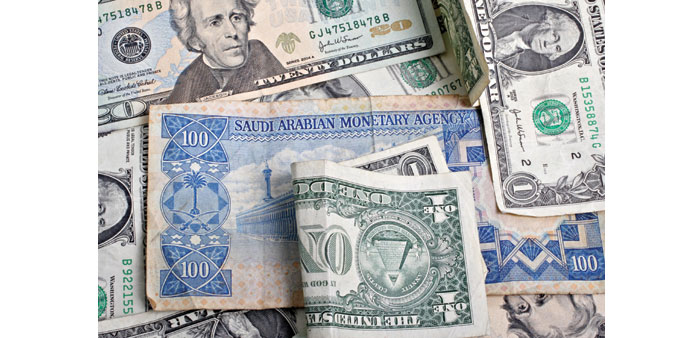A Saudi Arabian 100 riyal note and an assortment of US dollar bills are arranged for a photograph in New York in this photo taken on November 19, 2007. One-year US dollar/Saudi riyal forward points spiked over 3,000% in the five months leading up to a closing peak of 650 on November 24. And they are still trading at 475 now.
Bloomberg
The recent spike in US dollar/Saudi riyal forward points has prompted speculation that Saudi Arabia may abandon the riyal peg to the US dollar, but the country’s fundamentals and abundant reserves don’t justify such a move, writes Bloomberg strategist Mark Cudmore.
One-year US dollar/Saudi riyal (USD/SAR) forward points spiked over 3,000% in the five months leading up to a closing peak of 650 on November 24. And they are still trading at 475 now. While this move seems dramatic, it is important to note that 475 points is only equivalent to a 1.3% move in spot USD/SAR over the next 12 months. That means, the market is pricing in only a small chance of a devaluation after previously pricing in no chance.
Foreign exchange reserves may have fallen by about $95bn over the 12 months to October 31, but they still total around $648bn. The rate of the reserves’ decline is likely to slow as the budget deficit is set to shrink to 16% of the gross domestic product in 2016 from 19.7% of GDP in 2015, the current account balance is set to return to a surplus from 2.4% deficit in 2015, and the economy continues to grow at a stable pace.
The peg is very important for Saudi Arabia. It has been practically in place for nearly 30 years, and during periods of much greater stress, when oil prices were lower, and when Saudi Arabia had much less foreign exchange reserves than it does now. Devaluation has always been perceived as the option of last resort, and there seems to be no reason why this time is different.
Still, traders may be tempted to speculate on the riyal being devalued because it’s a cheap bet, and not because they have a high conviction it will transpire. The potential loss is small if nothing happens, while the payout may be very large on the slim chance the riyal is devalued. That’s because, if Saudi Arabia lets the peg go, it would probably allow USD/SAR to move significantly higher, as there is no incentive for only a small riyal depreciation that would just increase speculative pressure on the currency without securing any major economic advantage for the country. This can make the risk/reward analysis of the trade seem attractive, especially if it’s only a small part of a large portfolio.
l Mark Cudmore is an EM
strategist who writes for Bloomberg. The observations he makes are his own and are not intended as
investment advice.



